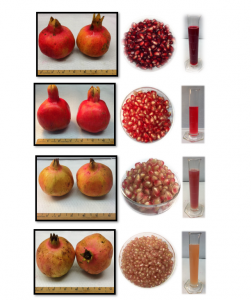
Aril and juice characteristics of some pomegranate varieties locally grown in Florida, fruit harvested in August 2018.
Ali Sarkhosh, assistant professor and Extension specialist at the Horticultural Sciences Department at the University of Florida, is researching how well pomegranates will grow in Florida’s climate.
The economic potential for growing pomegranates in Florida is currently unknown at this time. Research continues on the possibility of finding pomegranate cultivars that can grow in Florida. Florida’s wet season, accompanied by hot weather, are factors that will reduce the fruit quality of late-season fruiting of pomegranate varieties such as Wonderful. Therefore, the Wonderful variety, which is grown commercially in California, cannot be the right cultivar for Florida. Also, harvesting pomegranate in July and August will avoid marketing competition with California pomegranates.
While varieties with red skin and aril (seed) color are encouraged to be planted for commercial production, there are many pomegranate varieties with different fruit characteristics such aril color, taste, skin color, etc. that can be considered for the future.
Pomegranate fruit and juice have been used for thousands of years. Many studies have shown that pomegranate juice contains higher levels of antioxidants, even more than red wine and green tea. However, a small percentage of American citizens have tried pomegranate fruit, as it is not easy to peel the fruit off.
Today, pomegranate can be purchased at a few supermarkets not only as whole fruit and juice, but also as packed arils. An automated aril extraction machine with the capability of extracting arils of 100 tons of pomegranate fruit per day has been developed. There is a possibility that different pomegranate varieties with different aril colors will be packed for the market in the future, if more studies and sensory tests are done on fruit characteristics of these varieties.
To evaluate the fruit characteristics of locally grown varieties, fruits from 13 different pomegranate varieties were harvested in the first week of August 2018 from an orchard in Dade City, Florida. More than 20 fruit characteristics were measured, including fruit weight, aril and juice percentage per fruit, fruit appearance, sugar, acidity, antioxidant activity, etc. So far, the results of the study are promising, indicating that varieties that have difficulty in producing a good shape, size, and appearance of fruit under Florida’s hot, humid conditions and high pest pressure might be suitable to be used either for packed arils or for juice. One of the biggest problems is the diseases that develop during the hot/wet season, which reduces the quality of the fruit.
At the University of Florida, with the help of the Florida Pomegranate Association and growers, pomegranate research is being developed in different areas. Horticulturists, plant pathologists, physiologists and breeders are working on varying production issues in Florida to possibly make pomegranates a viable and economical tree fruit in Florida.
Acknowledgment: Ali Sarkhosh thanks Joseph Alexander, who harvested and delivered fruit to his lab.
Source: Ali Sarkhosh, University of Florida
Share this Post









